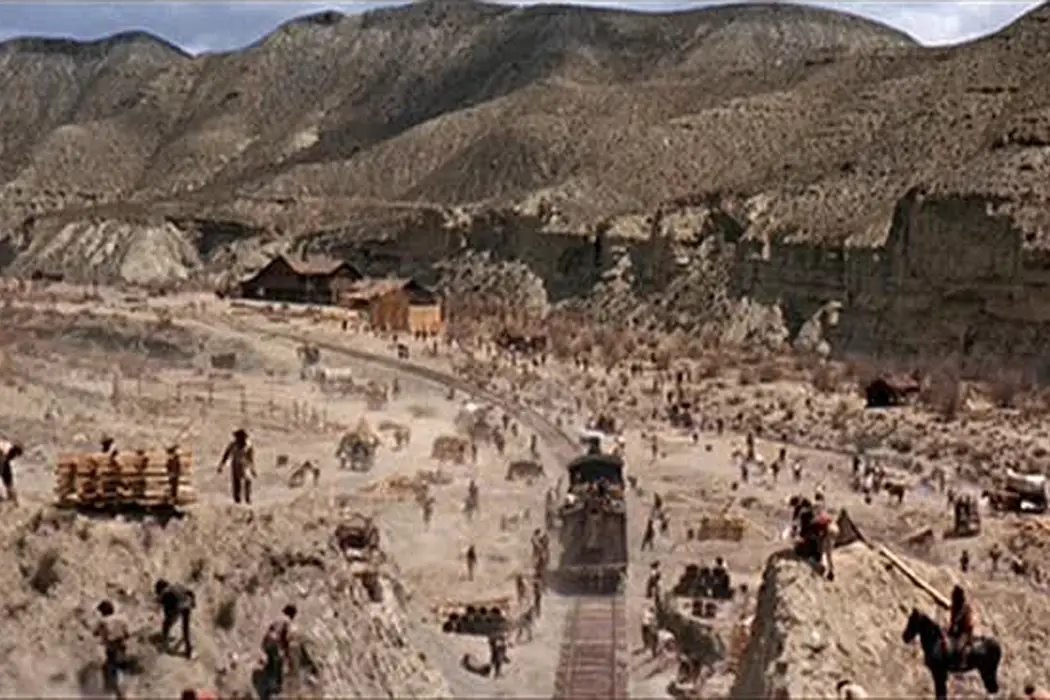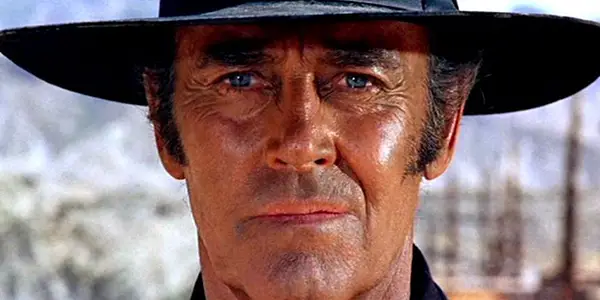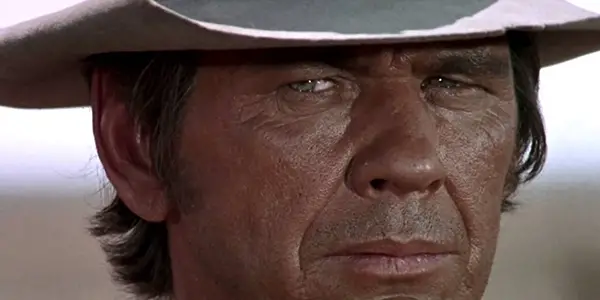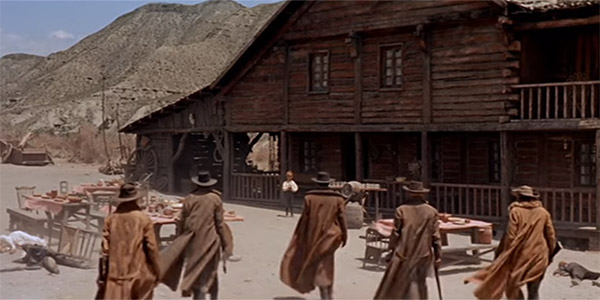ONCE UPON A TIME IN THE WEST: A Retrospective Look At The Classic Western After 50 Years

David is a film aficionado from Colchester, Connecticut. He enjoys…
To take a backwards glance at many classic Westerns now is to look back at history. Not only the history of America in the late 19th century, but the history of the genre and how it relates to standards and trends in the film industry of the time. Westerns in their prime, usually associated with the films of John Ford and John Wayne, are still fun to revisit, but their outdatedness often feels more clear now that mindsets and historical perspectives have changed. Some of the unfortunately common aspects for these films included: clear lines drawn between good and evil, a demonization of “the other,” typically Native Americans, and diminished roles for women, who were seen as a prize to be won.
But on the tail end of the classic era, you had the Spaghetti Western. The Italian take on the classic Western, these films often dealt with more sophisticated themes, were more gritty in nature, and had enhanced roles for women and people of color. Bad people were sometimes the heroes, and good people sometimes did unspeakable acts; their vision of the American West was often more realistic than what most Americans had provided before this.
At the very peak of the genre, you have the films of Sergio Leone, perhaps most known to the general public for his The Man With No Name trilogy starring Clint Eastwood, including The Good, the Bad, and the Ugly. But, to many, his peak artistic accomplishment is Once Upon a Time in the West. It provides every prominent aspect that you associate with Spaghetti Westerns, while also acting as a homage to the many films which preceded it. In the last 50 years, you can see just how far its influence has spread, across directors and even across genres. Let’s dive more into detail about how this film’s legacy has continued after half a century.
The Sound/Music
What immediately distinguishes Once Upon a Time in the West from the start is just how stylized it is, even more so than the way that Leone had done in his prior films. Its opening scene, for example, is an 8-minute, nearly dialogue-less segment concerning three characters at a train station. Clearly up to no good through their piercing glares alone, they quickly take command of the station, including overthrowing the bumbling old man taking tickets. With no score throughout, the only sounds heard are those of the station itself: the humming of a windmill, the buzzing of a fly, the opening of doors, the dripping of water. It is tensely-driven, slow-burning perfection, followed by the first glimpse of one of the film’s heroes, playing upon his signature instrument: Harmonica (Charles Bronson).

It’s scenes like this that show Leone at his most masterful, showing how he can build tension just through natural sounds. And on the flip side, just a few minutes later, you soon hear the first sounds of Ennio Morricone‘s masterful score: both in the next segment and then accompanying Jill McBain (Claudia Cardinale), who has just traveled to the West from New Orleans to be with her newly wed husband Brett (Frank Wolff). In a melancholy, poignant manner, Morricone‘s theme, aptly titled Jill’s America, seems to encapsulate the Old West itself, a place that represented a new beginning not only for Jill but for many Americans who chose to make the journey.
Throughout, Morricone extensively uses leitmotifs to introduce his characters. While we are still accompanying Jill on her journey to the McBain farm, she stops at a roadhouse, where we are soon introduced to my personal favorite, both character-wise and the theme that accompanies him. After a series of gunshots, the fiery Cheyenne (Jason Robards) soon enters, and his theme follows, which consists of a series of clanks, guitar strums, thuds, and whistles. Later, in this same scene, we are introduced once again to Harmonica. This time, he plays the same few notes, but now his theme is on full display, suddenly bursting into an explosive guitar riff when he meets face-to-face with Cheyenne, and the two size each other up.
It’s this clever, unconventional way of introducing and displaying connections between characters that Leone triumphs with throughout Once Upon a Time in the West. Whereas many movies prefer extensive dialogue, Leone simply lets sound, or lack thereof, do the talking.
The Story/Characters
After these initial sequences, the story driving Once Upon a Time in the West is soon unraveled. The four characters, who have now all been introduced, are each unwittingly brought together through a single act: an attack by Frank and his henchmen, which Cheyenne is subsequently blamed for, and which Jill is most affected by. Harmonica, on the other hand, is determined to meet up with Frank for an as-of-yet unknown reason. As the film progresses, we soon discover just what each of these characters is after, and how their choices eventually seal their fates.
The film’s screenplay was based on a story by Dario Argento and Bernardo Bertolucci, who before this were primarily known as film critics. In preparation for the film, Leone had tasked them with watching numerous classic Westerns, and what resulted is their own creation, based on references from those films. There are certain scenes that are direct homages, such as a funeral which is a shot-for-shot take from the movie Shane, while others, such as High Noon, which also involves characters waiting for an arrival from a train, are referenced, but then altered. Taken with this in mind, the film could’ve easily been derivative, but instead, Leone takes these Western tropes and subverts them instead, creating a new machine composed entirely of recognizable parts.

A significant way that Leone subverts expectations with Once Upon a Time in the West is with the characters portrayed. As mentioned earlier, many Spaghetti Westerns refused to place their heroes and villains into easily definable categories, resulting in depictions that are more true to life. In Once Upon a Time in the West, this can be seen through its four central roles and even through casting itself. Henry Fonda, for example, was mostly known before this for his classic Western heroes, many of which were in John Ford films, yet here he is cast as the clear villain of the story. His face still appears amicable and kind-looking, yet his actions speak otherwise. Even with this in mind, though, it’s hard not to feel at least some empathy for the character at moments, both through his arc and through Fonda‘s sensible portrayal.
Jason Robards‘ Cheyenne is another example. The character is the head of a band of outlaws, and is introduced at the start of the film as having escaped custody of the police for an unspoken crime. Yet, as we soon come to learn, Cheyenne, despite his faults, is actually quite a likable guy, and is very distinctive from the more sociopathic Frank. Robards steals nearly every scene he’s in, commanding the screen but also heartily winning us over through his portrayal.
Charles Bronson‘s Harmonica is more along the lines of Eastwood‘s character from The Man With No Name trilogy (Eastwood was actually offered the role originally, but turned it down). Yet, distinctive from the sometimes headstrong character in those films, Bronson‘s portrayal is equal parts mysterious and captivating, clearly harboring a deep-rooted and darker resentment within despite his outwardly calm demeanor.

And then there is Claudia Cardinale‘s Jill. The heart of the film, both through the story’s machinations and spiritually, Cardinale‘s performance stands as one of the most prominent examples of the “hooker with a heart of gold” trope. Far from a damsel in distress in constant need of saving, as she would be in nearly any other American Western, Jill is unwilling to let others control her fate. In addition, her sexuality is present, but never objectified, and though the film has a few questionable lines and moments that wouldn’t play well today, it is mostly a feminist triumph well ahead of its time. As is often pointed out by other characters (though somewhat unnecessarily), she is “quite a remarkable woman.”
As far as supporting characters, the one additional standout would be Gabriele Ferzetti‘s Mr. Morton, the leader of Frank’s gang. As a man marred by physical deficiencies, he is soon looked down upon by Frank, who sees his chance to rise higher in the ranks. Ferzetti is disabled, but he uses his financial prominence to fuel his status, showing how being formidable doesn’t always need to be of physical stature.
The Action/Visuals
Despite being known as an action film, Once Upon a Time in the West is actually not filled to the brim with action sequences. That’s not to say that it doesn’t have its share of memorable moments. There are those that are recognizable within Westerns, such as an impressively choreographed gunfight taking place on a train. Others, such as the opening sequence and the final duel, are more filled with tension through their buildup than the actual fights themselves. Still others seemingly come out of nowhere, such as one taking place as the character Frank walks out of a saloon into a formidable town. Throughout, Leone takes you through a loop, playing around with the tropes you would typically expect to see from an action scene in a Western.

Even more impressive than the action, though, is the way Leone uses space and visuals to capture a scene. At one point early on in the film, for example, you see the closeup of a young boy’s haunted face as he emerges from a barn, and as the camera zooms out, you see his expression change as he observes the surrounding incident that he has just heard. Then, from his perspective, you witness the following: one by one, several men wearing long-draped coats start to emerge from behind the brush, forming a small army as they slowly approach the boy. It’s the subtle use of this point-of-view perspective, coupled once again by Morricone‘s powerful score, that makes the scene all the more effective. Editing, sound, and visuals combine to place you right in the young boy’s terrified shoes.
Influence/Legacy
It’s not hard to see the influence that has spread since Once Upon a Time in the West hit the screens 50 years ago. One need look no further than Quentin Tarantino, who clearly idolizes the film, and Spaghetti Westerns in general, in his own Westerns Django Unchained and The Hateful Eight, with The Hateful Eight even being scored by Ennio Moriconne. Clint Eastwood not too long after began to direct his own films, including his own masterful revisionist Western Unforgiven in 1992.
The film’s influence can even be seen outside of the Western genre, such as in Vince Gilligan‘s Breaking Bad and its prequel Better Call Saul, two shows whose recognizable attributes include their quiet, meditative natures, prominent use of music, and intense focus on characters’ expressions. Morricone‘s score has since become iconic and is often celebrated as one of his best, with his themes having been sampled in titles as diverse as The Sopranos, Phantom Thread, and Pirates of the Caribbean: Dead Man’s Chest.
Once Upon A Time In The West: Conclusion
Admittedly, it’s still hard to display just what makes Once Upon a Time in the West such a masterful film. It’s an action film without much action, a character drama without much dialogue, an engaging story without much plot, a film ridden with references and homages of previous Westerns, yet it never feels derivative. Somehow, Sergio Leone compiled everything great about Westerns into one film, and then he subverted it just enough to make it not only celebratory of the genre, but as distinctive an entry as the world had ever seen. To me, it still stands as the greatest Western ever made. And even after 50 years, I don’t see that title going anywhere anytime soon.
What are your thoughts on Once Upon a Time in the West? What are your favorite Westerns? Let us know in the comments below!
https://www.dailymotion.com/video/x552gnb
Does content like this matter to you?
Become a Member and support film journalism. Unlock access to all of Film Inquiry`s great articles. Join a community of like-minded readers who are passionate about cinema - get access to our private members Network, give back to independent filmmakers, and more.
David is a film aficionado from Colchester, Connecticut. He enjoys writing, reading, analyzing, and of course, watching movies. His favorite genres are westerns, crime dramas, horror, and sci-fis. He also enjoys binge-watching TV shows on Netflix.













